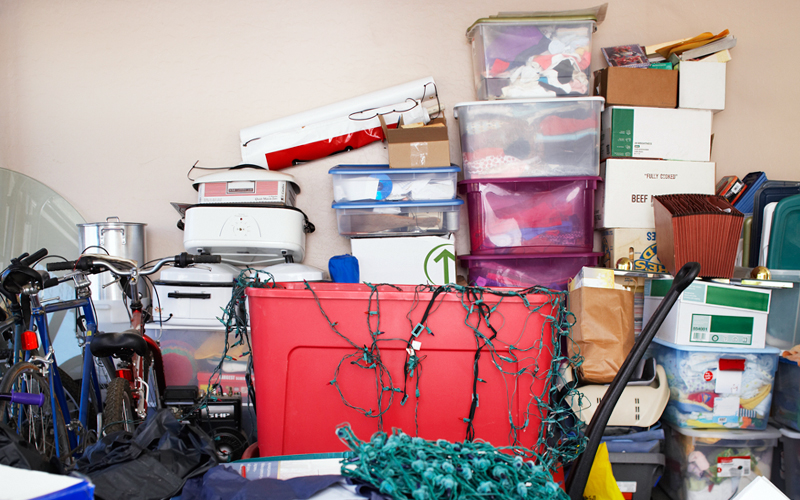
by guest blogger Leah Zerbe, online editor for RodaleNews.com
For as long as I can remember, I’ve kept my schedule packed to absolute capacity. I like to stay busy, and I took that to a whole new level when my husband and I moved back to my family farm several years ago to start organic farming (in addition to our full-time jobs).
The move was rushed, so packing wasn’t as organized as it should have been, and when we arrived to reexplore the old farmhouse and its many 100-plus-year-old buildings, we found we didn’t only have our own stuff to deal with, but also about five generations’ worth of old farm equipment, paperwork, books, and trinkets to sort through.
For the first few busy years, we kept pushing off the decluttering that so desperately needed to happen. (Some of our moving boxes still hadn’t been unpacked three years after the move!)
All of this avoidance of packing up and getting rid of what we didn’t need led to an unexpected problem: I packed on a few too many pounds. But luckily, as if sent by the decluttering gods, my path crossed with Peter Walsh’s when Rodale employees received an offer to test out the groundbreaking decluttering program outlined in his book, Lose the Clutter, Lose the Weight. And he was right: Your excess stuff really weighs on you. (Learn more about my decluttering journey.)
I still have work to do, but I want you to know that Peter got through to me in a way that no one ever had. I know this sounds corny, but with every bag of “stuff” I remove from my house, I swear my soul feels a little lighter. Because I want you all to feel better about your space (and yourself), I recently checked in with Peter and asked him to share some of his favorite organizing tips, including one for every room of the house:
1. Bedroom: Reverse clothes hanger trick. Turn all of the clothes hanging in your closet so that the hangers face back-to-front. For the next six months, if you wear an item of clothing, return it to the closet with the hanger facing the correct way. No cheating. If you try it on but decide not to wear it, make sure you put it back with the hanger turned backwards.
Be prepared for a shock. Because after six months, you’re going to look at which clothes are on hangers that are still facing in reverse. These are the clothes you have not worn. You should seriously consider getting rid of them all.
2. Kitchen: One-month cardboard box test. Not sure what you use and what you don’t in your kitchen? Here is a tried-and-true way to find out. Empty the contents of your kitchen utensil drawers into a cardboard box. For one month, only put a utensil back into the drawer if you take it out of the box to use it. At the end of the month, seriously consider discarding everything that’s still in the cardboard box.
Face it. If it’s still in the box after four weeks—you don’t need it. Pass it on to charity. (Want more tips on creating the most organized kitchen? Use this 10-step kitchen-decluttering plan.)
3. Bathroom: Read the numbers. All makeup has an expiration or use-by date. Sometimes it’s stamped on the product itself, sometimes on the packaging. Regardless, most makeup goes bad in six months! A good rule of thumb, however, is that the closer to the eyes the product is used, the shorter the lifespan. Mascaras go bad more quickly than everything else; they are good for about four months.
Other cosmetics, lotions, and such are generally good for about 12 months. Perfume has a shelf life of three years. On some perfume bottles, there is a manufacturer’s code listed on the bottom. This code and might look something like AJ6543. The last number, in this case 3, indicates the year in which the perfume was made. This number most likely indicates that the perfume was manufactured in 2013—hopefully not 2003. In this case, it would be good until 2016.
It’s always best to check with the manufacturer of the cosmetic if you are unsure how to determine the use-by date of that product. All cosmetics manufacturers have a customer-service number that can assist you. (Watch out for these other clutter hot spots, too.)
4. Home office: Go low-tech. Many people are uncomfortable with shredding or discarding paid bills. Peter says he’s seen homes where every receipt and paid bill for the previous 10 years is strewn throughout the house. If you want to keep paid bills and/or receipts, you need to keep the paperwork under control.
Start by purchasing a 12-month expanding file. When you pay bills for, say, June, place them in June section of the file. You’ll come back to June 12 months later. If you haven’t needed to look at the bills in that time, it’s highly unlikely that you’ll ever need them again. Shred them.
The same system works for receipts. Or a simple, very low-tech solution to organizing receipts is to use two bankers’ spikes. Get in the habit of cleaning receipts out of your wallet or purse daily. Place receipts on one of the spikes as they come in. When one spike is full, start the other. If you haven’t needed any of the receipts in the time it takes you to fill a spike, chances are you never will. When you fill up the second spike, throw out all the receipts on the first.
5. Garage: Label, label, label. Garages and basements are often used for seasonal items, sporting equipment, and holiday decorations, or medium- to longer-term storage. Be sure to clearly label any box, bin, or container that goes into the garage so that items can be easily and quickly located.
Consider different-color labels for boxes or containers of like things—orange for Halloween decorations, white for holiday lights, green for unread books. Stop right there! That was a trick! There should be no unread books in the garage!!
6. Kid’s room: Maintain limits. Kids outgrow everything quickly, including their interest in toys. It’s important to regularly sort toys with your kids to discard and pass on everything that they have outgrown, that they no longer play with, or that is damaged. Don’t do this on your own. Involve the kids in deciding what should stay and what should go.
Arrange the toys in distinct piles—either by type of toy, by age appropriateness, or by length of time the child has had the toy. This will help your children see the toys as distinct groups and make the task more manageable. Agree on the volume of toys that is reasonable to keep, factoring in the size of the space; work together toward that goal.
Be patient. Learning to part with the things that have memories can be tough. It always helps to schedule this purge right before a birthday or the holidays, times when kids are looking forward to some new toys.
7. Family room: The ratio-reduction rule. If you have a difficult time knowing where to start decluttering, try using the ratio rule to clear excess movies. For every four or five videos or DVDs you keep, remove one from your collection. Give the pulled movies away to charity, or if you have a friend or family member who would enjoy a particular movie, give it to that person. But be sure to set a deadline for all giveaways. At the end of this sort-and-purge, if your movies still do not fit on your selves, do the same thing again.
Try to lower the ratio to three to one or, if you are really brave, two to one. Challenge other family members to match or exceed the number of titles you’re passing on to others. Repeat the process until all your movies fit nicely on your shelves, with some spare room for new acquisitions.
 Leah Zerbe is online editor for Rodalenews.com. Prior to working at Rodale, she was the senior online editor at NBCPhiladelphia.com, where she headed up the station’s online “Going Green” initiative, wrote about center-city crime and traffic jams, and blogged about her beloved Philadelphia Phillies. She and her husband run a sustainable organic farm in Schuylkill County, where they grow vegetables, strawberries, herbs, and flowers and raise heritage-breed chickens.
Leah Zerbe is online editor for Rodalenews.com. Prior to working at Rodale, she was the senior online editor at NBCPhiladelphia.com, where she headed up the station’s online “Going Green” initiative, wrote about center-city crime and traffic jams, and blogged about her beloved Philadelphia Phillies. She and her husband run a sustainable organic farm in Schuylkill County, where they grow vegetables, strawberries, herbs, and flowers and raise heritage-breed chickens.
Adapted from the article “Super Busy? This Could Be the Missing Piece of Your Weight-Loss Puzzle,” which originally ran on RodaleNews.com.




No comments yet.